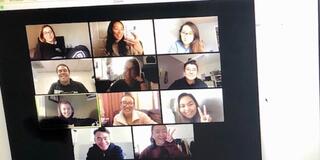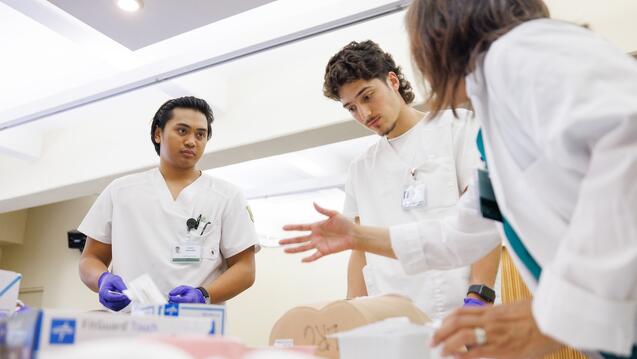Here’s What the First Week of Online Learning Looked Like

After wrapping up his first online class on pediatric nursing last week, Assistant Professor John Hurley invited his students to stick around and talk about what is helping them get through these days of isolation and disruption.
“Many said their pets,” said Hurley. “So next week after class we will stay in our Zoom classroom and the students are going to have a pet show.”
Learning in the time of coronavirus has changed how the classroom looks — but maybe not how it creates a community. For some at USF, the experience has been rewarding at a time when they are not physically together.
For others, though, online learning has been a challenge.
“I see and appreciate everyone doing their best at USF, but it makes me really sad for our school to be so dispersed at this moment, although it’s necessary,” said student Mira Nair ’22, a design major.
“There’s been so many uncertain feelings surrounding this pandemic and currently for me, it’s my classes,” she said. “As many art students feel, our classes are not very conducive for online learning. We are lacking equipment, software, and materials that are core to our learning. I know USF is trying to handle everything all at once, and our professors will be understanding, but it feels like art students will miss (learning some skills).”
It may take some time to work out the details — especially testing, said Amanda Burke-Aaronson, assistant professor in the School of Nursing and Health Professions.
“There were definitely growing pains as we all started working with the technology. That said, the first didactic class went well, but the lab time — clinical and simulation — will be interesting starting next week.”
Building a Classroom Community
For Hurley and his pet-loving class, it has helped to try to develop an online community, where once it might have happened naturally in a classroom. They’re planning to use Zoom to share artwork that they've created while social distancing.
“And we plan on keeping the community alive in new ways," said Hurley. "Some students are picking up old musical instruments that haven't been touched since starting nursing school. Perhaps another week we'll have online performances after class.”
For computer science student Ryan Dirajlal ’22, who is also majoring in biology, it hasn’t been easy staying at home in Florida and not getting to say goodbye to his friends.
But "classes have gone surprisingly well online,” he said. “Zoom offers so many features I did not know existed, and each of my classes are able to still do nearly everything we did while in face-to-face instruction. The creativity of the faculty and staff has really surprised me and I am impressed by the amount of work everyone is putting in. Keeping the same schedule with my classes online is helping to add normalcy to this situation.”
Engaging Students Online
Before online classes officially began, Kimberly Ding, clinical professor for sophomores at the School of Nursing and Health Professions, arranged an informal Zoom meeting with her students.
“I just wanted to check in with them and see how they were doing,” Ding said. “As nurses, we keep our chin up and are leaders during a time of crisis. My students and I are proud we went into this profession.”
At the School of Law, Professor Monalisa Vu, who teaches legal writing to LLM students, had never hosted an online class. Many of the students were spread out around the world, including one who joined the class from Brazil.
“It went really well,” Vu said. “The thing about this first online class, it was an oral argument class. We were supposed to show up in person and they were going to give oral arguments. It wasn’t me just talking at them; it was them presenting the materials. And we did it. We were sharing screens and looking at each other on screen.”
“Zoom video conferencing itself is a school,” said Rodrigue Ntungu LLM ’20. “The COVID-19 outbreak certainly helps envision the learning system of the future, dematerialized and personalized. But it most importantly offers professors and students the momentum to upgrade their class technology skills.”
Handling the Unexpected
For Fernanda Lopez Ornelas, geospatial analysis lab manager, her first online class went well — and she now knows she can handle just about any situation online.
“My students were very engaged and it was great that they all were comfortable using Zoom,” she said. “But about an hour after the lecture started, the fire alarm in my building went off, resulting in a very loud beep sound that made it unbearable to hear. This also woke up my 1-year-old daughter and upset my dog, so in one second I had an alarm, a kid crying, and a dog barking during my presentation.”
Ornelas told her class that they would take a five-minute break, and then she muted her microphone. Her husband called security, and there was no fire, just an alarm malfunctioning.
“After five minutes, I took my computer to the patio, where the alarm wasn't that intense and continued with my lecture until the alarm went off,” Ornelas said. “My class responded amazingly to the situation. I was able to go back inside and continue with the class and everything ended up perfectly fine.”


